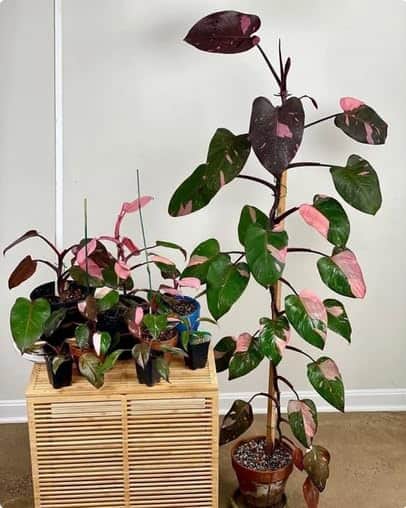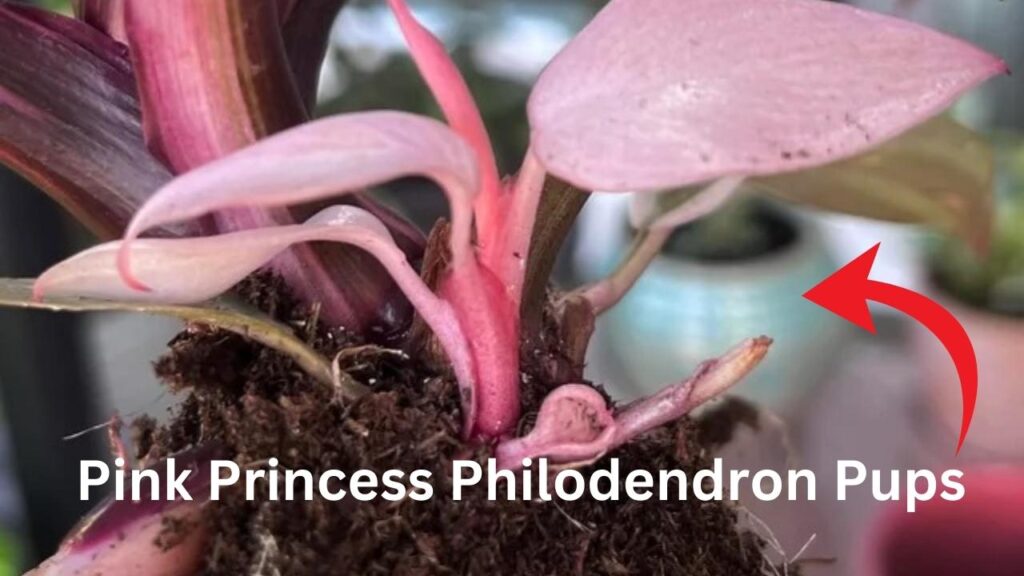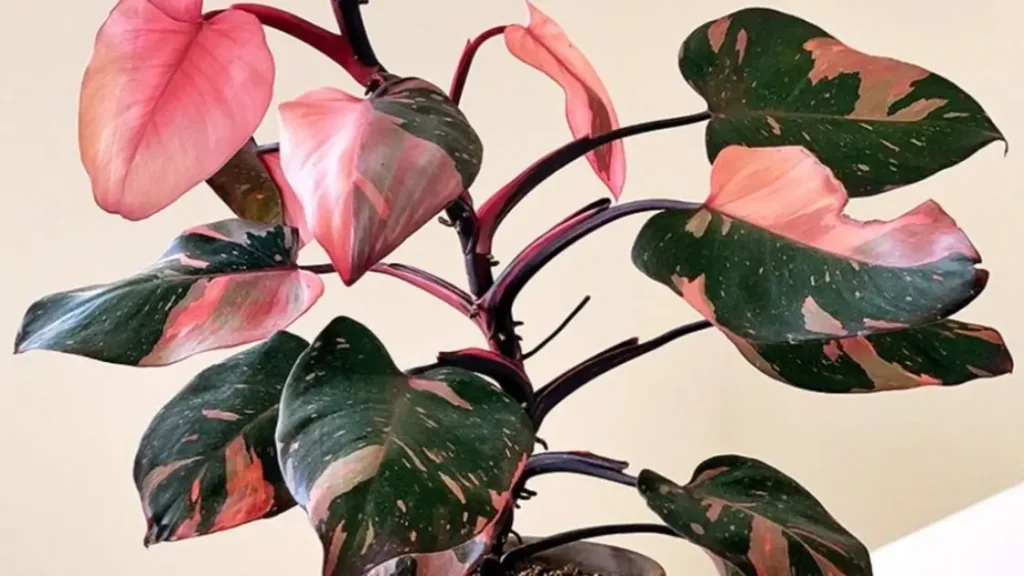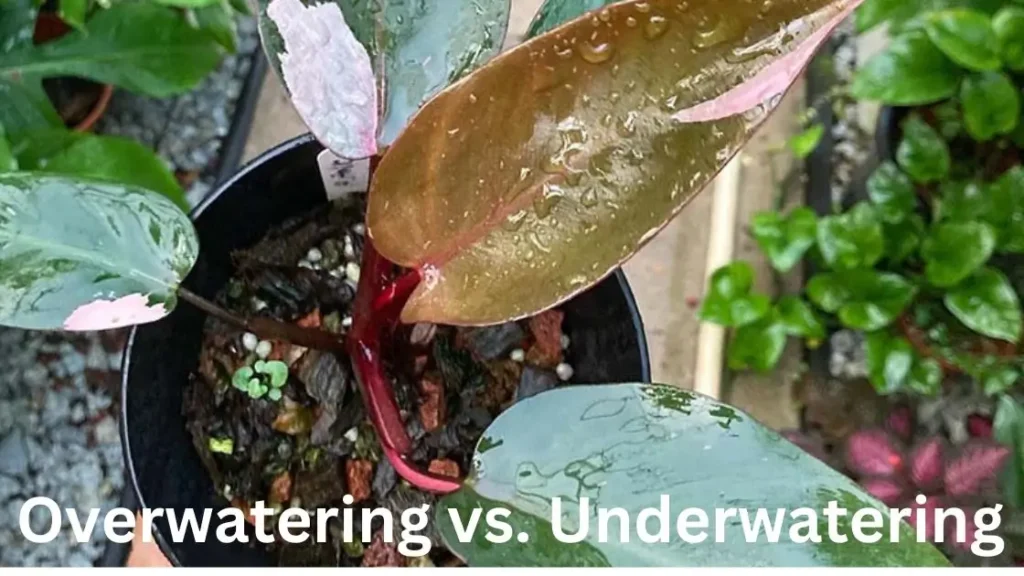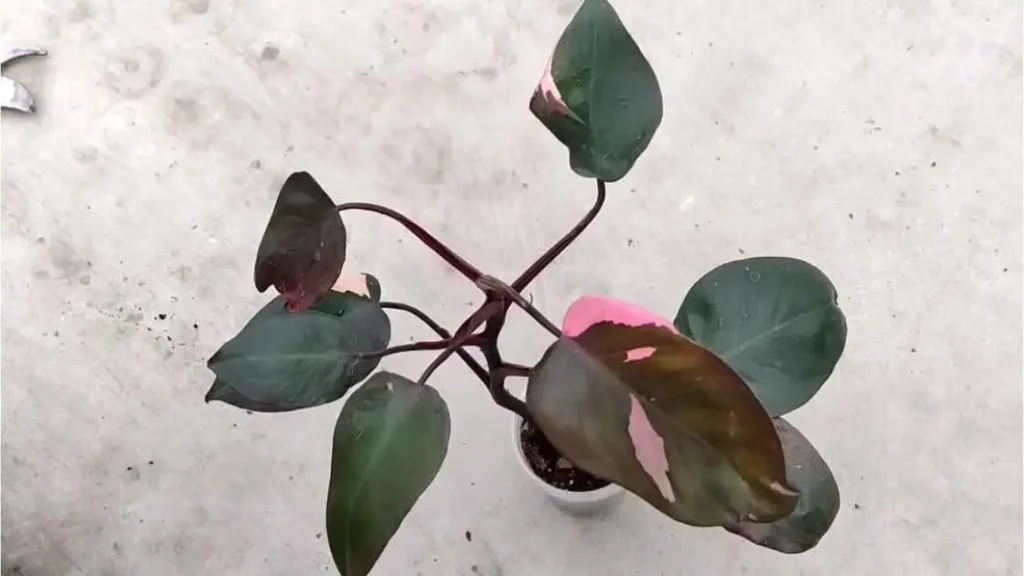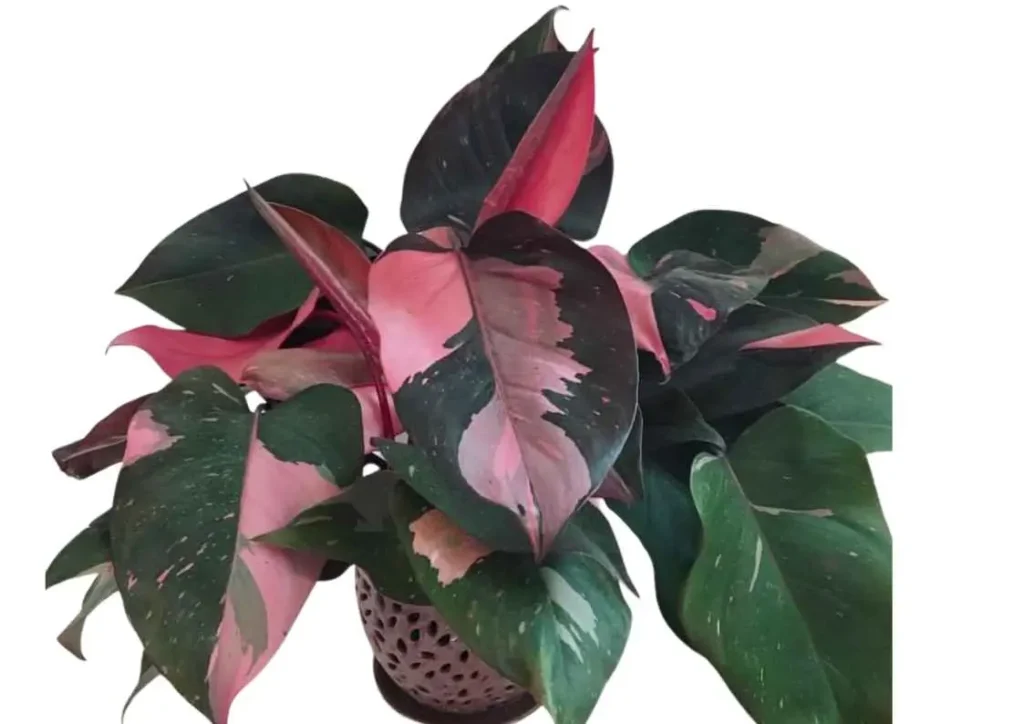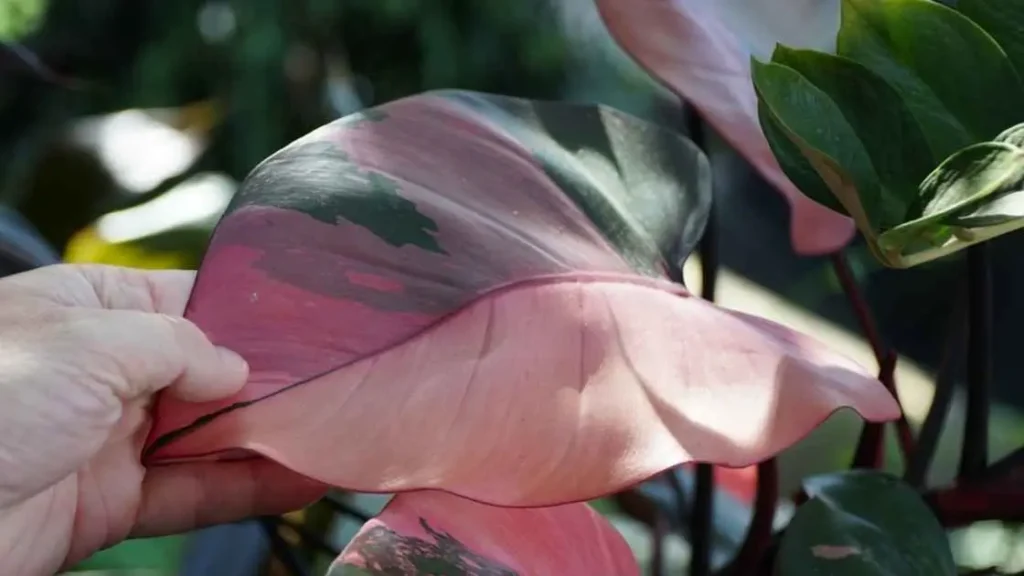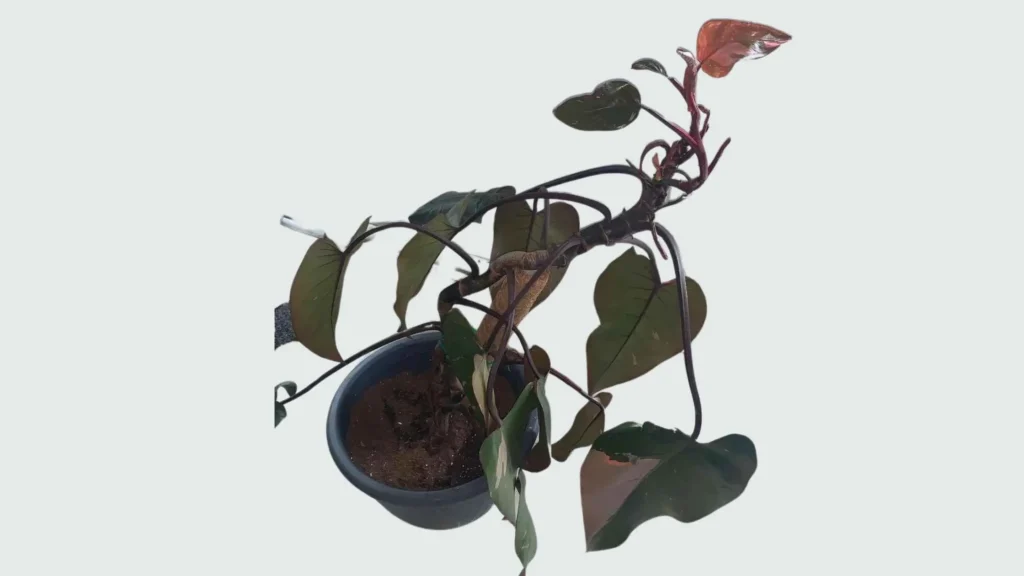Table of Contents
ToggleSo, you’ve got a Pink Princess Philodendron, and now you want to help it grow by teaching it to climb. You’re in the right place because I’ve been through this too. When I first got my Pink Princess, I loved its pink and green leaves. They made it the star of my plant collection. But soon, I learned that to help it grow better (and look even more beautiful), it needed a little help.
Here’s the deal: These plants can grow by hanging down, but helping them climb makes them healthier. It’s how they would grow in the wild. Plus, they grow bigger leaves that make your plant even more impressive.
In this guide, I’ll share what I’ve learned about helping Pink Princess Philodendrons climb. You’ll learn when to start, what to use for support, and how to tie the vines without hurting them. By the end, you’ll feel ready to help your Pink Princess grow tall—literally.
Let’s get started!
Understanding the Climbing Nature of Philodendrons
One of the coolest things about the Pink Princess Philodendron, besides its pretty pink and green leaves, is how it loves to climb. But what does that mean?
In the wild, these plants are called epiphytes. This means they use trees and tall things to climb toward the light. Imagine them in a jungle, growing up a tree, using their roots to hold on. Unlike other plants that grow up or out, the Pink Princess grows up, looking for light and support.
So why help it climb at home? While it can hang down, it does better when climbing. When it grows up, the leaves get bigger and brighter. If you want your plant to look healthy, letting it climb is the way to go. A climbing Pink Princess can grow tall instead of wide, which is perfect if you have more space going up than across.
Letting it climb also keeps it healthier. It gets more air and light, just like it would in nature. Plus, it looks really cool growing on a moss pole or trellis.
When I let my Pink Princess start climbing, the difference was amazing. The leaves grew bigger, looked brighter, and the plant seemed happier. It was a game changer!
Best Time to Start Training Your Pink Princess Philodendron
A common question I get is, “When should I start training my Pink Princess to climb?” Timing is important. You don’t want to rush, but you don’t want to wait too long either. The best time to start is when the plant is strong and has good roots. Usually, this is when the plant is 12-24 months old, depending on how fast it grows.
Let the plant adjust to its new home and build a solid base before you start training it to climb. You’ll know it’s ready when you see aerial roots growing from the stems. These roots are your plant’s way of saying, “I’m ready to hold onto something!”
When I started with my Pink Princess, I noticed around 18 months that the leaves were smaller and the aerial roots were getting bigger. This was a clear sign that it was time to introduce a climbing structure. But don’t worry if you’re a little late—Philodendrons are flexible and can still climb even if they’ve been trailing for a while.
It’s also best to start during the growing season, which is spring to summer. During this time, your Pink Princess will have more energy to grow and will take to climbing faster. If you start in the fall or winter, when the plant is resting, you might not see as much growth, and it could stress the plant.
In short, start training your Pink Princess to climb when it’s mature and growing. Look for aerial roots as a signal, and make sure it’s the right season for the best results.
Choosing the Right Support Structure
Now that you know when to start training your Pink Princess Philodendron, the next step is choosing the right support. The type of support you use can really change how your plant grows and looks. I’ve tried a few different options, so I’ll share what worked best for me and what might fit your space and style.
Types of Support for Climbing
- Moss Poles
Moss poles are my favorite choice for supporting climbing plants like the Pink Princess. Why? Because they feel like the tree bark these plants would cling to in the wild. The aerial roots of the Pink Princess will grab onto the moss, and over time, the plant will “hug” the pole as it grows upward.Moss poles are also easy to find, or you can make one yourself. If you like DIY projects, you can wrap some sphagnum moss around a strong stick and tie it with twine. This not only looks natural but also helps keep the air around the plant humid, which Pink Princesses love! - Bamboo or Wooden Stakes
If you prefer a simpler, cleaner look, bamboo stakes or wooden dowels are a good option. They are easy to use—just push them deep into the soil near the base of your plant. While they don’t have the texture of moss poles, they still provide strong support for the plant to climb. I’ve used bamboo stakes before, and while they look nice, it takes a little more work to attach the plant because the aerial roots don’t have much to grip onto. - Trellises
Trellises are both decorative and useful if you want your Pink Princess to grow tall and spread out in a certain shape. They come in materials like metal, wood, and plastic, so you can pick one that matches your style. Trellises give the vines something to wrap around. I’ve found that they work best if you want your plant to grow in a more artistic, vertical shape, not just straight up. - DIY Alternatives
Don’t want to spend extra on pre-made supports? You can use a large tree branch or build your own frame. A sturdy branch gives your Pink Princess a natural, wild look. This works well if your home has a rustic style. Just make sure the branch is secure in the soil so it doesn’t fall over.
How to Install the Support?
When I first added a support for my plant, I didn’t put it deep enough in the pot. Because of this, the support wobbled every time I watered the plant. So here’s what I learned: always make sure the pole or stake reaches the bottom of the pot. This keeps it stable. If you’re using a moss pole or stake, insert it when repotting to avoid disturbing the roots later.
Place the support close to the main stem. This helps the aerial roots grip the support. Whether you’re using a moss pole or trellis, start by loosely tying the vines to the support with soft ties, garden tape, or twine. Don’t tie them too tight—you don’t want to harm the delicate stems.
Maintenance and Upkeep
After you install the support, keep an eye on your Pink Princess as it grows. The plant will start climbing on its own, but you’ll need to adjust the ties as the vines get longer and thicker. I check mine every few weeks to make sure the ties aren’t too tight and the stems have room to grow.
Remember, you’re not forcing the plant to climb. You’re just guiding it! The more natural and gentle the process, the better your Pink Princess will look and stay healthy.
Step-by-Step Guide to Training Your Pink Princess Philodendron
Now comes the fun part—training your Pink Princess Philodendron to climb. Don’t worry, it’s easier than it sounds. Once you get started, it’s actually simple. I’ll guide you step by step based on what worked for me and some tips I’ve learned. Let’s turn your Pink Princess into the showstopper it’s meant to be!
Step 1: Prepare Your Support Structure
By now, you should have your support ready—whether it’s a moss pole, bamboo stake, or trellis. Before you start training, make sure the support is firmly placed in the pot. Push it deep into the soil, ideally to the bottom, so it doesn’t wobble or tip over. If you’re repotting your plant, it’s a good idea to add the support at the same time to avoid disturbing the roots later.
Step 2: Gently Guide the Vines
Once your support is in place, it’s time to guide the vines. Be gentle because Pink Princess stems are delicate. Take a longer vine and loosely wrap it around the support. If you’re using a moss pole, the aerial roots will start attaching to the moss on their own. For smoother surfaces like bamboo or wood, you’ll need to use ties.
Here’s a tip: Use soft ties or plant clips to attach the vine to the support. Plant velcro or stretchy ties work well because they’re adjustable and don’t squeeze the plant as it grows. Just make sure not to tie them too tightly—you want to leave room for the vine to grow.
Step 3: Train the Plant in the Right Direction
Plants naturally grow toward light, so if you want them to grow upward, place the light above your plant. This helps the vines climb straight up instead of spreading sideways. If you’re using a grow light, put it directly over the plant to guide its growth.
At first, you might need to adjust the plant as it grows. Watch for any vines that stray and gently guide them back to the support. Patience is key!
Step 4: Regular Adjustments
As your Pink Princess grows, it will start attaching to the support, but you still need to adjust it from time to time. Every few weeks, check the ties or clips to make sure they aren’t too tight or hurting the stem. As the plant gets bigger, you may need to loosen the ties or move the vines to keep the plant healthy.
I also use this time to prune any damaged or yellow leaves. This helps the plant focus on climbing and keeps it looking neat. Pruning also encourages fuller, healthier growth.
Step 5: Encourage Humidity and Good Lighting
Climbing Pink Princess Philodendrons grow best in humid areas. To help them grow faster and healthier, raise the humidity around your plant. You can do this by misting the leaves, using a humidifier, or placing a tray of water nearby.
For light, these plants prefer bright but indirect sunlight. Keep them out of direct sun to prevent leaf burn. If your plant is growing toward the light but not climbing, you may need to adjust the light setup to help it grow upward. Good lighting helps the plant grow taller.
Optimal Care for Climbing Pink Princess Philodendrons
Now that your Pink Princess is climbing, you’ll want to give it the best care to support its growth. Like any plant, a climbing Pink Princess needs the right balance of light, water, nutrients, and a good environment to thrive. Based on my experience and research, here’s what will keep your plant healthy and growing strong.
Light Requirements
Pink Princess Philodendrons love bright, indirect light. If you’re like me, you might think putting your plant in a sunny window will help it grow faster, but direct sunlight can burn its beautiful leaves. You don’t want the pink color to fade or get burnt! Keep your plant in a spot with lots of natural light, but not harsh sun.
If you don’t have much natural light, don’t worry. Grow lights are a great option, especially in darker months. I’ve used a grow light above my Pink Princess, and it not only keeps it happy but also helps it climb up instead of growing sideways.
Watering Tips
Watering is important, and it’s where many people (including me) make mistakes. Pink Princess Philodendrons like their soil to stay moist, but not too wet. Waterlogged roots can cause big problems, like root rot.
Here’s what I do: I water my plant when the top inch of soil feels dry. I make sure to water it well, allowing the water to drain through the holes in the pot. A tip I follow is to never let the plant sit in standing water—empty the saucer! The key is consistent moisture, but too much water can cause trouble.
In the winter, the plant grows more slowly, so you can water it less often. I wait longer between waterings during this time to avoid overwatering.
Fertilizing Schedule
For feeding, I’ve found that regular fertilizing in spring and summer helps keep my Pink Princess healthy. I use a balanced, water-soluble fertilizer, diluted to half strength, every 4-6 weeks. This gives the plant a boost without giving it too many nutrients.
In fall and winter, when the plant is not growing much, I stop fertilizing. The plant doesn’t need extra nutrients during this time. One thing I learned the hard way is that over-fertilizing can cause leaf burn, so it’s better to be careful!
Humidity and Temperature
Pink Princess Philodendrons love humidity. If you live in a dry area, your plant may struggle, and the leaves might become smaller or wrinkled. Aim for at least 50% humidity, but higher is even better.
At home, I use a small humidifier to keep the air moist around my plants, and I’ve seen a big difference. You can also group your plants together to create a mini humidity zone or place a shallow tray of water near the plant (just make sure the roots aren’t sitting in water).
As for temperature, Pink Princesses like warmth. I keep mine in a spot where the temperature stays between 65-85°F (18-29°C). They can handle a small drop at night, but try not to let it fall below 55°F (13°C), as that can slow their growth.
Common Problems and How to Fix Them
Even with the best care, plants can have bad days, and the Pink Princess Philodendron is no different. But don’t worry—most problems can be fixed with a little care and adjustment. Here’s a look at some common issues you might face while training your Pink Princess to climb, and how to fix them.
1. Failure to Climb
One common problem is that your Pink Princess may not climb as expected. Instead of growing upward, it might start trailing or not attach to the support. This happened to me, and I realized my light wasn’t set up right. Here are a few things that could be going wrong:
- Lack of Proper Support: Your plant needs something to hold onto, like a moss pole or trellis. If the support is too smooth, like a bamboo stake, the aerial roots may not attach easily. If this happens, try wrapping some moss around the stake to help the roots latch on.
- Inadequate Lighting: If the light is too far away or not above the plant, it might not grow upwards. Plants grow toward the light, so if it’s coming from the side, your Pink Princess may trail in that direction instead of climbing. Make sure your light is above the plant to encourage vertical growth.
- Weak or New Growth: If your Pink Princess is young or doesn’t have many aerial roots yet, it may need more time before it’s ready to climb. Be patient—give it the right care and time to grow.
2. Yellowing or Dropping Leaves
Yellow leaves on your plant can mean a few different things. Here’s what might be going wrong:
- Overwatering:
This is the most common reason for yellow leaves. I made this mistake when I started gardening. My plant’s leaves turned yellow and droopy because I gave it too much water. Let the top of the soil dry out before watering again. Also, make sure the pot has good drainage so the roots don’t stay too wet. - Underwatering:
On the other hand, if your plant doesn’t get enough water, the leaves might turn yellow and fall off. Check the soil to make sure it stays moist, but not dry. - Low Humidity:
Philodendrons love humid air. If the air is too dry, the leaves may turn yellow or brown at the edges. You can fix this by using a humidifier or spraying water on the leaves.
3. Sparse or Weak Growth
If your Pink Princess is growing, but the leaves are small and the plant looks thin, it may not be getting enough light. This happened to me when I moved my plant to a darker spot. The leaves became smaller, and the new growth was weak.
- Solution:
Move the plant to a place with brighter, indirect light, or use a grow light. More light will help the plant grow larger and healthier leaves.
If you are fertilizing regularly but still see weak growth, check your plant for pests. While not common, spider mites, aphids, and mealybugs can slow growth. Look for tiny webs, sticky spots, or discolored leaves. If you see these signs, treat the plant with neem oil or insecticidal soap.
4. Leggy Growth or Stretching
Leggy growth means the plant is reaching for more light. The Pink Princess Philodendron, like most vines, will grow longer if it doesn’t get enough light from above.
- Solution:
Cut back the leggy parts and move the plant to a spot with brighter, indirect light. Trimming helps the plant focus its energy on growing stronger and fuller leaves.
5. Leaf Reversion (Loss of Variegation)
One of the best things about the Pink Princess is its pink leaves. But sometimes, the plant starts growing all-green leaves. This is called reversion. It can happen when the plant doesn’t get enough light or is stressed.
- Solution:
If your plant is reverting, move it to a brighter place to help bring back the pink leaves. You can also cut off the green leaves to help the plant focus on growing pink ones. Just be careful not to cut off too many at once.
Maintaining Your Pink Princess Philodendron
Once your Pink Princess starts climbing, the work doesn’t end. Like all plants, a climbing Philodendron needs care to stay healthy. This section will cover the main tasks to help your Pink Princess grow tall and strong while looking great.
1. Pruning for Better Growth and Variegation
Pruning is very important for keeping your Pink Princess healthy, especially if you want to manage its pink leaves. I learned early on that the all-pink leaves, while beautiful, don’t have any chlorophyll. This means they don’t help the plant make energy, and too many pink leaves can weaken the plant.
Here’s what I do: I prune my Pink Princess when it starts growing too many all-pink leaves. This helps the plant focus on making pink-and-green leaves, which are both pretty and useful. Also, remove any fully green leaves because they can cause the plant to lose its pink color over time. Don’t worry about pruning too much—your plant will grow back with healthy new leaves.
2. Checking and Adjusting Ties
As your Pink Princess climbs, it’s important to check the ties or clips holding the vines. Over time, the stems grow thicker, and the ties can get too tight if not adjusted. Every few weeks, I check the ties and either loosen them or move them to new spots if needed.
If the vines are outgrowing their support, it may be time to add another section to the moss pole or use a taller stake. Adjusting the ties regularly helps the plant grow freely without being pinched, which can stop its growth.
3. Monitoring for Pests
Philodendrons are tough plants, but they can still get pests like spider mites, aphids, or mealybugs. I’ve had some problems with pests, and the best way to handle them is to find them early. I check my plant’s leaves and stems every time I water it to spot pests before they spread.
If you do see pests, wipe the leaves with a damp cloth or spray them with neem oil. I like neem oil because it works well and is safe for plants and pets. Regular checks will keep your Pink Princess healthy and free of pests.
4. Seasonal Adjustments
As the seasons change, your plant’s needs change too. In spring and summer, I water and fertilize more often to help the plant grow. But in fall and winter, I water and fertilize less since the plant grows slower.
I used to make the mistake of watering my Pink Princess the same way in winter. This led to overwatering and yellow leaves. Now, I let the top two inches of soil dry before watering during colder months. Your Pink Princess will be happier if you adjust its care for each season!
Conclusion
Training your Pink Princess to climb is rewarding for both the plant’s health and how it looks in your home. From helping it climb to giving the right care, there’s a lot involved in keeping your plant happy. But trust me, it’s worth it.
When I first started, I didn’t know how much climbing could improve my plant’s health and look. Now, watching it grow tall with bigger, brighter leaves makes all the care pay off. Whether you’re new to plant care or improving your skills, these tips will help you grow a strong, beautiful Pink Princess.
Remember, every plant grows at its own speed, so be patient and keep caring for it. Soon, you’ll have a climbing beauty your plant-loving friends will admire!
Good luck with your plant-parenting journey! Come back to these tips if your Pink Princess needs a little extra care. You’ve got this!
FAQs
When should I start training my Pink Princess Philodendron to climb?
Start training your Pink Princess Philodendron to climb when it’s about 12-24 months old. Look for strong roots and aerial roots on the stems. These show that the plant is ready to hold onto something. Spring or summer is the best time to start because your plant will grow faster.
What kind of support is best for helping my Pink Princess climb?
A moss pole is the best support for your Pink Princess. It feels like tree bark, which the plant’s roots can easily hold onto. You can also use bamboo stakes, wooden sticks, or a trellis. Moss poles are the best for helping your plant grow tall and strong.
How do I attach my Pink Princess Philodendron to a support structure?
Gently guide the vines toward the support. Use soft ties, garden tape, or twine to hold the vines in place. Don’t tie them too tight—you don’t want to hurt the plant. Over time, the roots will grab onto the support on their own.
What should I do if my Pink Princess Philodendron isn’t climbing?
If your plant is not climbing, check these things:
Is it getting enough bright, indirect light?
Is the support strong and set up well?
Is your plant old enough and does it have aerial roots?
Why are my Pink Princess Philodendron’s leaves turning yellow?
Yellow leaves can mean overwatering, underwatering, or low humidity. Keep the soil moist, but don’t let it sit in water. Make sure your plant gets enough humidity. Check for root rot and adjust your watering if needed.
How do I encourage bigger, healthier leaves on my Pink Princess Philodendron?
To get bigger leaves, make sure your Pink Princess gets bright, indirect light. Help it grow on a moss pole or other support. Keep the soil moist and the air humid. Also, feed it with a balanced fertilizer during spring and summer.
Related
Discover more from Pink Philodendron
Subscribe to get the latest posts sent to your email.

